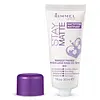What's inside
What's inside
 Key Ingredients
Key Ingredients

 Benefits
Benefits

 Concerns
Concerns

 Ingredients Side-by-side
Ingredients Side-by-side

Water
Skin ConditioningCyclopentasiloxane
EmollientTalc
AbrasiveCetyl PEG/PPG-10/1 Dimethicone
EmulsifyingAluminum Starch Octenylsuccinate
AbsorbentPropylene Glycol
HumectantVinyl Dimethicone/Methicone Silsesquioxane Crosspolymer
Isononyl Isononanoate
EmollientPolypropylene
Silica
AbrasiveSilica Dimethyl Silylate
EmollientDisteardimonium Hectorite
StabilisingMagnesium Sulfate
Bis-PEG/PPG-14/14 Dimethicone
EmollientGlycerin
HumectantLaureth-7
EmulsifyingTribehenin
EmollientXanthan Gum
EmulsifyingPhenoxyethanol
PreservativePropylene Carbonate
SolventSorbitan Sesquioleate
EmulsifyingChlorphenesin
AntimicrobialTocopheryl Acetate
AntioxidantDisodium EDTA
Triethoxycaprylylsilane
Pentaerythrityl Tetra-Di-T-Butyl Hydroxyhydrocinnamate
AntioxidantCI 77891
Cosmetic ColorantWater, Cyclopentasiloxane, Talc, Cetyl PEG/PPG-10/1 Dimethicone, Aluminum Starch Octenylsuccinate, Propylene Glycol, Vinyl Dimethicone/Methicone Silsesquioxane Crosspolymer, Isononyl Isononanoate, Polypropylene, Silica, Silica Dimethyl Silylate, Disteardimonium Hectorite, Magnesium Sulfate, Bis-PEG/PPG-14/14 Dimethicone, Glycerin, Laureth-7, Tribehenin, Xanthan Gum, Phenoxyethanol, Propylene Carbonate, Sorbitan Sesquioleate, Chlorphenesin, Tocopheryl Acetate, Disodium EDTA, Triethoxycaprylylsilane, Pentaerythrityl Tetra-Di-T-Butyl Hydroxyhydrocinnamate, CI 77891
Dimethicone
EmollientWater
Skin ConditioningDimethicone/Vinyl Dimethicone Crosspolymer
Skin ConditioningVinyl Dimethicone/Methicone Silsesquioxane Crosspolymer
Trimethylsiloxysilicate
EmollientSilica
AbrasiveGlycerin
HumectantCetyl PEG/PPG-10/1 Dimethicone
EmulsifyingIsododecane
EmollientPhenoxyethanol
PreservativeSodium Chloride
MaskingDimethicone/PEG-10/15 Crosspolymer
Magnesium Sulfate
Sodium Benzoate
MaskingDisteardimonium Hectorite
StabilisingC24-28 Alkyl Methicone
EmollientPropylene Carbonate
SolventDipropylene Glycol
HumectantSodium Citrate
BufferingTocopherol
AntioxidantDimethicone, Water, Dimethicone/Vinyl Dimethicone Crosspolymer, Vinyl Dimethicone/Methicone Silsesquioxane Crosspolymer, Trimethylsiloxysilicate, Silica, Glycerin, Cetyl PEG/PPG-10/1 Dimethicone, Isododecane, Phenoxyethanol, Sodium Chloride, Dimethicone/PEG-10/15 Crosspolymer, Magnesium Sulfate, Sodium Benzoate, Disteardimonium Hectorite, C24-28 Alkyl Methicone, Propylene Carbonate, Dipropylene Glycol, Sodium Citrate, Tocopherol
 Reviews
Reviews

Ingredients Explained
These ingredients are found in both products.
Ingredients higher up in an ingredient list are typically present in a larger amount.
This ingredient is a high molecular weight silicone. It has emulsifying and skin conditioning properties.
Disteardimonium Hectorite comes from the clay mineral named hectorite. It is used to add thickness to a product.
It can also help stabilize a product by helping to disperse other ingredients.
Hectorite is a rare, white clay mineral.
Learn more about Disteardimonium HectoriteGlycerin is already naturally found in your skin. It helps moisturize and protect your skin.
A study from 2016 found glycerin to be more effective as a humectant than AHAs and hyaluronic acid.
As a humectant, it helps the skin stay hydrated by pulling moisture to your skin. The low molecular weight of glycerin allows it to pull moisture into the deeper layers of your skin.
Hydrated skin improves your skin barrier; Your skin barrier helps protect against irritants and bacteria.
Glycerin has also been found to have antimicrobial and antiviral properties. Due to these properties, glycerin is often used in wound and burn treatments.
In cosmetics, glycerin is usually derived from plants such as soybean or palm. However, it can also be sourced from animals, such as tallow or animal fat.
This ingredient is organic, colorless, odorless, and non-toxic.
Glycerin is the name for this ingredient in American English. British English uses Glycerol/Glycerine.
Learn more about GlycerinMagnesium Sulfate is a salt. More specifically, it is an epsom salt, or the bath salt used to help relieve muscle aches.
Despite having ‘sulfate’ in the name, it isn’t a surfactant or cleansing agent like sodium lauryl sulfate. Unlike those sulfates, magnesium sulfate doesn’t have the same cleansing or foaming properties (it's simply a type of salt).
In cosmetics, Magnesium Sulfate is used to thicken a product or help dilute other solids. It is a non-reactive and non-irritating ingredient.
One study shows magnesium deficiency may lead to inflammation of the skin. Applying magnesium topically may help reduce inflammation.
You can find this ingredient in sea water or mineral deposits.
Learn more about Magnesium SulfatePhenoxyethanol is a preservative that has germicide, antimicrobial, and aromatic properties. Studies show that phenoxyethanol can prevent microbial growth. By itself, it has a scent that is similar to that of a rose.
It's often used in formulations along with Caprylyl Glycol to preserve the shelf life of products.
This ingredient is a solvent. It helps dissolve active ingredients and alter the texture of products.
Propylene Carbonate is commonly used in makeup and with clay, such as montmorillonite or bentonite.
Studies show this ingredient to be safe for cosmetics. When it is undiluted, it can cause skin irritation. (It is always diluted in skincare and makeup). This ingredient is water-soluble.
Propylene Carbonate is created from propylene glycol and carbonic acid.
Learn more about Propylene CarbonateSilica, also known as silicon dioxide, is a naturally occurring mineral. It is used as a fine, spherical, and porous powder in cosmetics.
Though it has exfoliant properties, the function of silica varies depending on the product.
The unique structure of silica enhances the spreadability and adds smoothness, making it a great texture enhancer.
It is also used as an active carrier, emulsifier, and mattifier due to its ability to absorb excess oil.
In some products, tiny microneedles called spicules are made from silica or hydrolyzed sponge. When you rub them in, they lightly polish away dead skin layers and enhance the penetration of active ingredients.
Learn more about SilicaThis ingredient is used in makeup and skincare to thicken formulas, reduce shine, and give skin a silky-smooth feel.
It’s a white silicone powder that sits in fine lines and pores to blur their appearance though its effectiveness depends on the particle size.
You'll typically find this ingredient in amounts between 0.1-20%.
Learn more about Vinyl Dimethicone/Methicone Silsesquioxane CrosspolymerWater. It's the most common cosmetic ingredient of all. You'll usually see it at the top of ingredient lists, meaning that it makes up the largest part of the product.
So why is it so popular? Water most often acts as a solvent - this means that it helps dissolve other ingredients into the formulation.
You'll also recognize water as that liquid we all need to stay alive. If you see this, drink a glass of water. Stay hydrated!
Learn more about Water